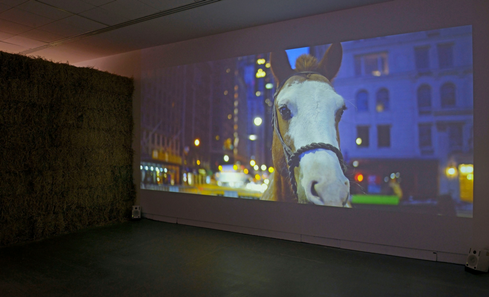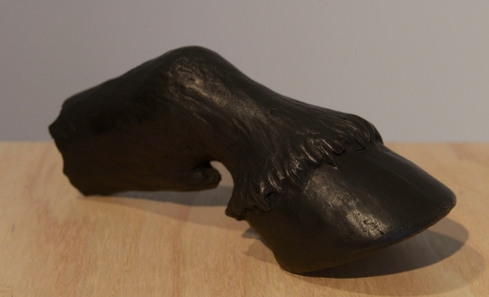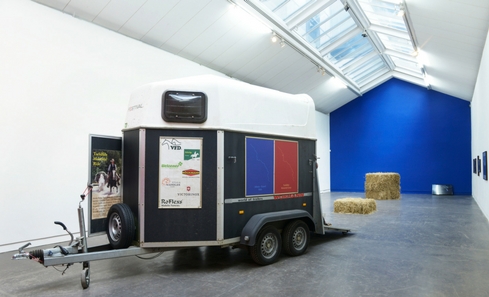
It's a Tuesday morning in April, and CCA's exhibition gallery is covered in straw. Huge, perfect cubes of the stuff fill various vacuums in the space - and yes, it has a smell.
But Ross Birrell, the Paisley-born artist behind the straw (and the accompanying exhibition) explains that the smell is intentional. In fact, it's all part of the sensory experience that is The Transit of Hermes: a new work which was originally commissioned for Documenta 14, and is now being shown at Glasgow International in partnership with CCA.
In short, the story behind the work follows Hermes the horse on a 100-day expedition."I wanted people to get a real sense of what that journey was like," Birrell says. "When you walk in, it’s sensory – you can smell what the journey might have been like” (hence - straw).
This exhibition aims to explore “literal and metaphorical journeys, traversing north and south, human and animal, myth and materiality". In it, Birrell employs a rich range of media, including photography, sculpture and film, all of which resonate on the concept of being in transit.
One of the central focus points of the show is a specially-created three-hour silent film, which captures the experience of a horse’s 100-day long-ride journey from Athens to Kassel. The straw and other accompanying objects, such as a horse trailer, are there to add sensory elements to the piece.
But that 100-day long ride is just one aspect of Hermes’ journey. Supporting the film is a series of photographs, as well as Criollo: a short work documenting key moments from a wider journey from New York to Buenos Aires. As Criollo opens, we see a solitary horse at the threshold to Central Park at the end of 6th Avenue - Avenue of the Americas.
A series of accompanying photographs then document the animal’s journey via air and road transportation as it appears at three identical equestrian statues to the Argentine leader, José de San Martín, in Buenos Aires, Washington D.C., and New York.

Criollo was inspired by Tschiffely’s Ride: a 10,000-mile journey from Buenos Aires to New York (1925-1928), undertaken by Swiss-Argentine rider Aimé Félix Tschiffely on two Argentine criollo horses, Mancha and Gato. As CCA's exhibition programme notes: "The criollo horse is a mixture of Arab and Barbary breeds, the name stemming from ‘creole’ with associations of social and cultural mixing.
"Tschiffely’s account was published in 1933, the same year Hitler seized power in Germany, implementing a bio-politics of hatred based upon an ideology of racial purity. In contrast, Tschiffely’s Ride is dedicated “to many friends – of whatever race, nationality or creed – who did their utmost to make rough places smooth.”
Birrell had a clear idea of what themes this exhibition should resonate on - notions of identity, ambiguity and journeying. But there were also practical issues to consider in the creation of the work.
"Because I'm not an equestrian, I've never worked with horses before," Birrell says. "I had to work with someone who worked with animals closely. There was a man called Peter van der Gugten who was actually running a ride in the Swiss Alps, on rides across difficult terrain. He was a member of the Long Riders Guild, and that was a whole series of individuals who were experiences long riders.
"Because I wasn't intending to do a long ride from Buenos Aires to New York, I needed someone who could work with that. But also, because Athens to Kassel was rideable as a distance and duration, there was a suggestion of long ride there, which Peter would be able to lead. So that was developed over two years."
The Athens-Kassel Ride was subsequently undertaken by van der Gugten, along with David Wewetzer, Zsolt Szabo and Tina Boche, and their equine companions (Artvin, Issy Kul, Paco and Calfino Sancho). The ride traced a 3000km trail through Greece, Macedonia, Serbia, Croatia, Slovenia, Austria and Germany. Such was the team power behind this, that Birrell describes himself as "part of an ensemble", rather than an individual. The horse that undertook the journey was named Hermes, "after the God of border crossings. He goes between two worlds simultaneously. He has an ambiguous identity, and he's going from somewhere to somewhere. He's also a gift horse, which has its ambiguity. So there's a layering of myth and meaning there."

"In the film, The Transit of Hermes, which has been edited for this exhibition at CCA, Hermes really is in perpetual motion. He doesn't begin in any recognisable place and he doesn't end in any recognisable place. The photographs which surround the space are very clearly mapping a journey. So there is a departure point and arrival point. In the film, there is no clear departure and arrival point."
Birrell worked with a variety of media to capture different expressions of the journey. He says: "There's sculpture, there's installation, there's a bronze hoof of Hermes that we made. I work with digital film and photography, and what I'm interested in is the different ways to capture the experience I'm encountering. You have a very different experience between the moving image and the still image.
"We chose not to use any of the copious amounts of moving image documentation of the ride day-to-day - we pared it down to strict photographic moments instead. Because it's fragmenting - you're never going to be able to experience the fullness of the ride.
"The moving image in this space is really just the rest moments. It's the day-to-day routine of resting, repairing and saddling up. The film of the Transit of Hermes is a 100-day journey made into a three-hour silent film."
Despite the overarching themes and messages, ambiguity still has a part to play here. "You're never really told why the project was undertaken," Birrell says. "Really, it remains as a question for the viewer.”
See The Transit of Hermes at CCA, Glasgow, Friday 20 April – Sunday 3 June 2018, as part of Glasgow International Festival.